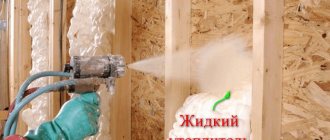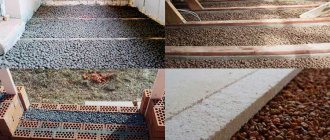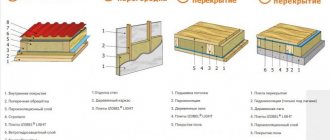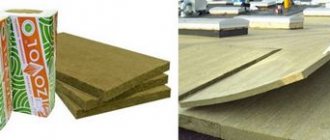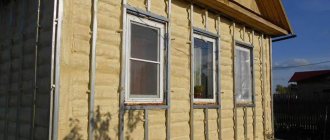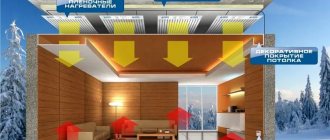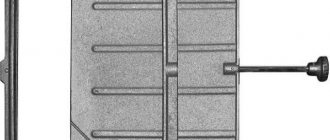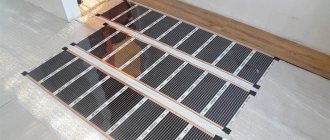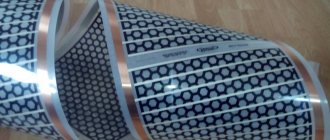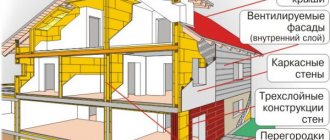Hello friends!
I haven’t visited my blog for a long time, I have a lot of work. I've set aside an evening to write an article for readers. In general, today we will talk about insulation for window openings. Recently I witnessed in a hardware store how a sales consultant, frankly without understanding the issue, talked about the pros and cons of self-adhesive insulation to an elderly couple.
I stood nearby, listened, and felt so sad at how illiterate the young people were... well, if you work in this field... study everything thoroughly so as not to make a fool of yourself. Well, okay, I grumbled and that’s enough :). In general, I have prepared the material, read it. Maybe it will be useful to someone!
Sealing window openings
We will talk about sealing the window opening, which is necessary for thermal insulation (protects against drafts, prevents heat loss in winter), but not only.
Window insulation maintains a comfortable microclimate in the apartment during hot summers; prevents dust, street odors, and insects from entering the house; dramatically reduces the noise level, which is especially important if your windows overlook a highway or tram line.
First of all, window insulation is necessary for old wooden frames (a high-quality and well-installed plastic window does not always require additional insulation measures).
There is one caveat: in the old days, glass was often installed in the frame using a special mastic, and it tends to crumble over time. The paint on the frames is cracking, and the wood itself is cracking over time. Small cracks should be filled with sealant before laying insulation.
Obviously, the main requirement for window insulation is its quality. When selecting, you also need to take into account the specifics of the cracks on your window - width, shape.
Energy-saving double-glazed windows
The main components of heat loss through the glass part of a window are convection, thermal conductivity and thermal radiation, and the main indicator of energy saving is emission (glass emissivity). That is, a reduced numerical value of the emitter entails a reduction in heat loss. The low emission value of the double-glazed window coating gives it an energy-saving function. They allow short waves of solar radiation to enter the room, but block long waves of thermal radiation from a battery or other heat source from leaving the room. Glass with such coatings is called low-emissivity.
Self-adhesive insulation
Insulation materials are divided into adhesive, groove and self-adhesive.
The easiest way to install is self-adhesive. It can be foam rubber, rubber, made of polyethylene foam or PVC. There is insulation for plastic windows in black, white and brown. The material is quite durable and allows you to seal cracks up to seven millimeters wide.
When choosing self-adhesive insulation for windows, be sure to look at the expiration date. If you buy rubber or plastic insulation, it is better to take a softer one.
Foam or polyethylene (tubular or rectangular) is suitable for sealing gaps up to four millimeters, provided that the gaps are fairly level. Otherwise, you need to pay attention to the brand: up to three millimeters, profile C, E, K is suitable, up to five - P, V, up to seven - B, O.
More on the topic Thermal film for windows
To seal not very wide cracks, you can use a rubber seal; for uneven and wide cracks, it is better to choose silicone, it is more flexible.
Insulate the slope
It is possible that replacing a double-glazed window or gluing a heat-saving film will not solve the problem completely. If the window installation was carried out incorrectly, then it will not be possible to insulate the window with “small losses” and additional protection will be needed around the perimeter of the window opening. Slope insulation can be done using various materials:
Styrofoam.
Pros:
This material is quite economical and easy to install.
Cons:
Subject to destruction and changes in characteristics with constant temperature changes.
Mineral wool.
Pros:
Fire resistance, environmental friendliness
Cons
: Difficult to install
Penoplex (extruded polystyrene foam).
Pros:
It has better characteristics when compared with polystyrene foam.
Cons:
More expensive than other materials
Important to consider! All of the above options require further finishing.
Sandwich panel.
Foam rubber
Foam rubber insulation for windows (foam rubber tapes) was used to seal windows for the winter long before the production of insulation was put into production.
The advantages of this material are known to everyone: it is easily compressed (and, as a result, installed), does not injure the surface of the frame, this method is cheap and simple.
There are also disadvantages: foam rubber for insulating windows is not the best choice; even with very good compression, air still leaks through the pores, and it is also not very durable - foam rubber comes off relatively easily.
The second problem can be partly solved by modern rubber-based adhesives. To solve the first part of the cracks (especially in hard-to-reach places), it is advisable to fill them with silicone or acrylic sealant before installing the insulation.
Cost table
Self-adhesive insulation is sold wholesale and retail, as well as in coils (large skeins) and in small packages for private use. Below is a comparative table that will help you see the approximate cost of 1 linear meter from different manufacturers and from different materials.
| Manufacturer | Country of Origin | Cost of 1 linear meter | Packaging cost | Length (meters) | Insulation model | Material |
| Deventer | Germany | 42 | 250 rub. | 6 | S7256 | EPDM |
| Profitrast | Russia | 10 | 90 rub. | 9 | Standard, Profitrast | PVC |
| Economy | Russia | 3.6 | 44 rub. | 12 | PVC | |
| KIMTEC | Germany | 12 | 18 rub. | 1.5 | EPDM | |
| AVIORA | China | 8.2 | 82 rub. | 10 | Foam rubber | |
| – | Russia | 3.9 | 39 rub. | 10 | PPE | |
| Scotch tape for window insulation | Russia | 2.84 | 142 rub. | 50 |
It is clear that German insulation for windows made of synthetic rubber is the most expensive. Although their price is within reach. 40-50 rubles per linear meter is not so much, considering that one window requires 3-5 meters. You can insulate all the windows in an apartment for about 2,000 rubles.
Insulation tape
Adhesive paper tape for window insulation is sold in any construction supply store or markets, and is inexpensive.
Previously, strips of thick paper were used instead; they were placed on soap. The presence of an adhesive layer on the tape eliminates the need to use soap, and this type of sticking lasts much better. It is usually placed on top of foam rubber.
EPDM – rubber tape. Suitable for sealing uneven cracks of small width. It perfectly seals cracks and withstands temperature changes from minus fifty to plus seventy.
Silicone insulation tape also withstands strong temperature changes and is indifferent to chemical influences. This is a very plastic material, suitable for large uneven cracks.
Vinyl polyurethane has a porous surface. This tape has good dustproof properties, but is not the best option for thermal insulation. Moreover, it is not the most durable.
Silicone sealant
Silicone sealant is suitable for insulating old wooden windows, as it:
- has high strength;
- lasts a long time;
- abrasion resistant;
- withstands temperatures from -80 to 200 degrees;
- has good elasticity, ensuring reliable tightness;
- has a long service life, identical to the operating life of the window.
Silicone sealant is twice as expensive as regular sealant, but the price is justified by the period of use.
To apply sealant, you should:
- remove spatulas, old putty;
- remove the glass;
- sand the frame where the glass is installed;
- apply sealant;
- insert glass;
- paint the spatula;
- apply sealant to the putty on the side in contact with the window;
- insert spatulas, hammer in small nails for better fastening.
Laying insulation
Whatever materials you choose for insulating windows, it is recommended to glue seals at temperatures above five degrees, so it is better to take care of the tightness of windows in advance, without waiting for frost.
More on the topic: Which is better to choose - single-chamber or double-glazed windows?
First, you need to remove the old insulation for wooden windows, if any, clean the frames from dirt and degrease (gasoline, acetone, alcohol, or any composition based on them will do). It is necessary to glue in places where the sash comes into contact with the frame, removing the protective film gradually as the insulation is laid.
Source: enoza.ru/okna/regulirovka-nastroyka-i-reshenie-problem/uteplitel-dlya-okon-porolonovyiy-lenta-plenka.html
More recently, old-fashioned methods were used to insulate windows. Some people glued newspaper to the windows, and others glued strips of paper.
Cotton wool, tape or paraffin were also especially popular.
Of course, such insulation methods were not only inconvenient, but also ineffective. Everything changed when self-adhesive window insulation appeared on the market.
We insulate plastic windows
If the seal on your PVC windows is worn out, it needs to be replaced.
- The first step is to remove the old product from the surface of the window. To do this, use a utility knife, spatula or screwdriver.
- Now that you have a sample of rubber tape on your hands, you need to visit a hardware store and purchase similar insulation for windows.
For your information! You shouldn’t throw away the old seal, you will need it.
- When you get home, cut the new tape into the required lengths using the old tape. The margin should not exceed 2-3 cm, they are needed only for adjustment.
- Take a non-sharp object in your hands, a plastic ruler will do, and carefully press the insulation into the groove.
There is a special tool with a rotating roller for this.
- Once the seal is secured around the perimeter, cut off the excess edges. The tape should fit into the groove in the spacer.
As you can see, replacing old insulation on plastic windows yourself is not so difficult.
Self-adhesive tape
Insulating window structures is a very important process that must be approached very carefully.
Uninsulated windows often cause drafts, which as a result negatively affect the health of residents.
In addition, window openings become the main bridge of cold, which leads to the loss of a large amount of thermal energy.
Today, the market offers a large selection of modern insulating materials that can reduce heat loss through window units.
All these materials are highly effective and very easy to install. Among all the options, it is worth highlighting self-adhesive tape.
It is made on the basis of foam rubber, polyethylene and polyvinyl chloride. On one side, the material is coated with a sticky compound, which allows it to be fixed in a specific place.
Advantages of self-adhesive insulation
This self-adhesive window insulation has certain advantages.
These include:
- Ability to close cracks, the thickness of which can reach 7 mm;
- High resistance to changes in temperature and air humidity;
- Various colors, which allows you to optimally aesthetically fit the tape into the appearance of the window;
- Relatively low cost;
- Possibility to open the doors.
Thanks to these advantages, this material has gained high popularity and demand among the population.
Disadvantages of the material
Unfortunately, duct tape also has some disadvantages. First of all, it is worth noting its fragility. Most often, it lasts no more than one season.
This means that the insulation needs to be updated annually. Of course, if the doors are rarely opened, then the tape can last two or more seasons.
Despite the fact that such material tolerates temperature changes very well, severe frosts can negatively affect its performance properties.
As a result of exposure to too low temperatures, the adhesive composition may lose its adhesiveness. As a result, this leads to the tape peeling off.
The main disadvantage of such insulation is that it cannot be used on modern window structures. This is due to the fact that it can cause significant harm to the performance characteristics of plastic windows.
Vapor barrier device
There are three layers:
- From the inside - thermal protection prevents heat loss from the room to the street
- The middle load-bearing insulating layer provides thermal insulation and sound insulation. These problems are solved by polyurethane foam or other porous material. It is rational to include vapor barrier self-adhesive tapes in this inner layer if the window unit is installed in wet rooms - kitchens, baths or showers
- The outer layer waterproofs the joint and protects against the penetration of cold street air
Vapor barrier tapes are available with a one-sided adhesive layer and double-sided. A one-sided sticker is used if the film is mounted on the side surface of the window frame. Double-sided tape gives an advantage in choosing fasteners: on the frame or in the window opening. According to climatic versions, tapes are also produced in two types - for areas with low winter temperatures - a winter version of the tape, and for areas where temperatures do not fall below +5⁰С - a summer version.
The base for the adhesive layers of the tapes is butyl rubber or metal.
Main types of vapor barrier tapes:
- PSUL, or pre-compressed sealing tape, is used for finishing and vapor barrier of external joints, ensuring a tight connection between the window frame and the external wall. The base material is butyl rubber; the thickness and elasticity of the tapes provide good insulation.
- BC - vapor barrier tapes for sealing joints for dry finishing of slopes - made of plastic or plasterboard. sizing with BC tapes reduces the risk of condensation.
- VM - vapor barrier tapes attached to the window frame, with an overlap, in order to improve the thermal insulation of joints.
- GPL is a polyethylene foam tape, laminated on one side, with metal strips and an adhesive layer over the entire width.
In addition to the main layer of non-crosslinked polyethylene foam, which is 2 mm thick and is waterproofing, the GPL tape has a second layer - both vapor barrier and protective. The thickness of the outer layer is only 20 microns, the material is polypropylene.
GPL tapes are used for all types of door and window blocks as universal ones. They combine two tasks - waterproofing and vapor barrier. The structure of foamed polyethylene is elastic and closed-porous, so the material does not absorb moisture and its hygroscopicity is almost zero. The tapes are flexible and suitable for installation on uneven surfaces. Metal lamination and the quality of the main polymer (polypropylene as a protective layer) determine chemical resistance in both acidic and alkaline environments, and as a result, good durability of GPL tapes.
They produce GPL tapes in standard width sizes of window and door units, width 9; 12; 15; and 20 cm, in rolls of 15 m.
How to choose a ribbon
The choice of self-adhesive insulation for windows must be approached very carefully. The tape is made from various materials and can have different profiles. This is worth considering when choosing it.
If you decide to use a rubber band, it is better to choose the softest one. Thanks to this, the insulation will reliably close all the cracks and reduce heat loss from the window structure to a minimum.
As already mentioned, insulation can have a different profile. When solving this issue, it is worth paying attention to the nature of the cracks.
If the gaps between the frame and the sash are straight, you can use rectangular profile insulation. It can be used to seal cracks up to 4 mm thick.
In other cases, the optimal solution would be materials with profiles of various shapes that resemble letters of the Latin alphabet.
For example, material with an “O” profile allows you to hide uneven cracks, the thickness of which can reach 7 mm.
When choosing insulation, special attention should be paid to the expiration date.
If it has expired, the adhesive properties of the tape have decreased significantly. As a result, this can lead to it quickly peeling off from the window.
Materials you can use
We will look at different options so that you can understand both how to insulate plastic windows and how to insulate wooden frames. These are different types of structures, and working with them can be very different.
I'll start with the simplest solutions, at the beginning of each section it will indicate what type of windows the technology is used for, so that you learn only what suits you.
Option 1 - cotton wool and paper
This is the cheapest insulation for window frames, which is used on wooden structures. The technology involves working indoors, since paper and cotton wool are not intended for outdoor use.
As for recommendations for carrying out work, they are as follows:
| Illustration | Description |
| Cotton wool. It can be bought at any pharmacy, the price is low, but the reliability is not the best. You need to change the insulation every year, even if you don’t open the doors. Cotton wool absorbs moisture and begins to deteriorate over time. It is better to purchase the option, as in the photo - in the form of a roll; such cotton wool is much easier to separate and stuff into the cracks. | |
| Paper for covering windows. Regular thick strips, sold in small rolls. A very cheap, but not very reliable material, which is used less and less these days. | |
| Masking tape or paper tape. A more convenient solution is a tape with a self-adhesive layer. The convenience is that you can choose options of different widths to seal the cracks efficiently and reliably. The main disadvantage is that with constant changes in temperature and humidity, the tape can come off.
| |
| The cotton wool is pushed tightly into the cracks. The better the voids are filled, the warmer it will be in winter. The work is carried out with any suitable tool, it can be a small spatula, a screwdriver or something else. | |
| If paper tape is used, it must be lubricated with soap. Everything is very simple here: a bar of soap is moistened in water, after which the tape is rubbed along its entire length. The paper should become damp, do not skip any sections. | |
| The tape is carefully glued to the joint. The main thing is to position it evenly and press it against the surface along its entire length. After drying, the paper will stick well to the frame. To remove it in the spring, you just need to wet the surface. | |
| With duct tape everything is much easier. You need to gradually glue it along the joint. To better press the tape to the surface, use a cloth. In the spring, the tape is simply carefully separated from the frames; usually this process does not cause difficulties. |
Option 2 - special insulation tape
There are two main options here:
This is what the heat tape looks like
- Self-adhesive foam tape. This option can be used both for cracks in the frame and for joints by gluing the material to the open sash. Foam rubber has good thermal insulation properties, so it retains heat well.
Foam tape with self-adhesive layer
As for the application, everything is very simple:
- Self-adhesive insulation is simply glued in the right place. If there is a gap around the perimeter, then the foam rubber can be pushed into it with a spatula. It is important to close all places through which heat is lost and press the material tightly to the surface;
The tape must be pressed tightly to the surface
- The sashes are insulated with foam tape by gluing it around the perimeter. The material can be placed both on the frame and on the sash - wherever is more convenient for you. The protective layer is removed from the tape and it is pressed tightly along the entire length of the joint.
Foam rubber compresses well, so it is often used for frame and sash joints
Option 3 - rubber seal
Can be used on both wooden and plastic structures. Its main purpose is to seal the joint between the sashes and the frame. Thanks to this, heat loss through this part of the structure is reduced tenfold.
If you are figuring out how to insulate wooden windows for the winter, then you will need a universal option that can have different widths. The thickness of the rubber bands is selected for a specific structure, so that after closing the sash the joint is tight.
The seal is simply glued around the perimeter of the frame
As for the rubber tape for plastic windows, it is selected depending on the brand of profile used. Just tell the store what brand your windows are from, and they will give you the right seal.
For plastic windows, special rubber seals with a special profile are produced
Please note that for reliability in plastic systems, the elastic can be glued to both the frame and the sash.
Option 4 - putty or silicone
If the first option can only be used on wooden structures, then the second is suitable for both wood and plastic. The following can be noted here:
- The putty can be used both inside and outside. This is a special composition that is sold in hardware stores and is specifically designed for sealing the joints of glass and frame. Applying the putty is very simple: roll the compound into a thin sausage, which you press against the edge of the window frame, and then form an inclined surface so that moisture drains from the joint;
The putty is easy to use
- Silicone can be used for both plastic and wooden windows. In the first case, it will be used to seal the junctions of ebbs or cracks around the perimeter, and in the second, beads can be glued to the silicone. This will make the connection airtight and prevent the glass from rattling. You can apply the composition to the gap between the bead and the glass if you did not do everything right away.
Silicone does not allow air and moisture to pass through
Tape installation
The installation of self-adhesive tape must be approached very carefully. The quality of its fastening and the effectiveness of insulation will depend on this. Before you start gluing it, you need to carefully prepare the working surface.
To do this, the frame must be cleaned of old insulation and all contaminants. After this, the place where the tape is attached must be thoroughly washed and degreased. You can use alcohol or acetone to degrease the surface.
More on the topic How to make a heated floor on a balcony with your own hands
Once the surface is ready, you can begin attaching the material. To fix the insulation at the line of contact between the sash and the frame, the protective paper is removed from the back side.
It must be eliminated gradually, as needed. To facilitate the installation process, the tape can be pre-cut into pieces of a certain length.
The material easily sticks to the frame. But, complete hardening of the adhesive composition occurs after some time. During this time, you should refrain from frequently opening and closing the sash.
Nuances of the gluing process
with all the important details before starting work :
- The surface of the frame or glass must be thoroughly cleaned. Remove any remaining old glue.
- Fill all cracks with foam rubber.
- Then the surface will need to be degreased with an alcohol solution.
- Be sure to wait until it dries completely.
- Remove the protective tape from the insulation.
- Place the adhesive side on the frame and press gently. Strong tension is not allowed.
The time for complete adhesion of the tape is 2 hours.
After the specified time, you need to check the quality of the insulation. To do this, just bring the flame of a lighter and make sure that the fire does not fluctuate.
Modern film
Today you can also find self-adhesive film on the market. This material appeared on the market relatively recently, but has already gained great popularity among the population.
Using such a film, you can significantly improve the thermal insulation properties of the entire window unit. If the tape seals the cracks, then the film reduces heat loss over the entire area of the window opening.
This insulation takes the form of a regular film, which has a special coating on one side. This makes it easy and quick to mount it on a window.
To give it aesthetics and somewhat hide its presence, heating devices such as a household hair dryer are used. When heated, the film straightens and becomes almost invisible.
Its installation can be easily done with your own hands. Unfortunately, such insulation is used only for one season, or rather one period - in winter.
The disadvantage of the material is that it protects the room well from both cold and heat that comes from outside. As a result, in the spring the room warms up very slowly.
To eliminate this drawback, it is necessary to dismantle the film immediately with the onset of heat.
Source: kak-uteplit.ru/samokleyushhijsya-uteplitel-dlya-okon.html
It seems that the modern world is simply unimaginable without new products and inventions; it cannot help but create them due to the urgent need for it. In a modern economy, in repairs or construction, sometimes it is impossible to count the number of useful things that, without exaggeration, deserve their place.
Variety of models
Manufacturers offer several options for hermetic seals. In most cases, rubber and PVC are used as a base. Each of them has a set of characteristics:
- features of installation and fastening to the surface;
- degree of durability;
- the ability to withstand external negative factors.
In popular models, the described factors fully cope with the assigned tasks. Each type of tape has detailed installation instructions from the manufacturer to ensure optimal results.
The following types of tapes are found on the shelves of construction stores:
- self-adhesive (with an applied adhesive layer);
- grooved (designed for installation in cut grooves);
- adhesive (having a surface on which glue is supposed to be applied for fixation).
Each option is selected based on actual conditions and the condition of the window.
Self-adhesive rubber strips
Modern self-adhesive tape for window insulation is made on the basis of rubber, polyvinyl chloride, and polyethylene foam. Plastic materials make it possible to compress such insulation to the required state in order to minimize gaps. During production, various dyes are used that make this element less noticeable against the background of the window.
Different shapes of ribbons
The following colors are selected:
- white;
- brown;
- black.
The tape has not only a decorative difference between different models. It is also differentiated by the possibility of hiding gaps. The most popular versions of its design are capable of blocking gaps from 3 to 7 mm in increments of 2 mm. Each interval has its own index. Although there are no ideal gaps in frames, you can always choose the best option.
VIDEO: Window insulation - experiment
Use of foam rubber
You can get rid of annoying drafts spreading from poorly sealed frames by installing self-adhesive foam tape for insulating windows. The product blocks heat from escaping outside the room.
Insulating windows using foam rubber and tape
The main shape for such tapes is a rectangular profile. Among the wide range, it is always possible to choose the most optimal option, since the models differ in the following characteristics:
- dimensions (section and length);
- degree of rigidity (relevant for uneven gaps);
- color range (easy to match the frame from white and beige to gray and black);
- the presence of an adhesive layer (self-adhesive can be applied to one of the sides).
Foam rubber was one of the first to be used for such purposes due to its physical properties. It has a lot of advantages, remaining one of the popular materials with the following characteristics:
- good compression ratio;
- there is no frame injury;
- affordable cost per linear meter;
- easy to install/dismantle;
- copes with the task quite effectively.
However, with all the advantages it has disadvantages:
- with significant differences in the gap, air leaks in;
- has a relatively short service life;
- in cheaper models, this adhesive tape for window insulation is weakly fixed;
- poorly resistant to moisture.
If you need to temporarily get rid of a draft, then foam rubber is a quick and easy way to solve this problem, at least for the winter season.
For ease of installation on windows and joints, it is worth purchasing foam rubber with an adhesive base. This material stays on the surface longer, is elastic enough to last for several seasons and regulates the tightness of the sashes.
Tubular seal
Manufacturers of tapes for insulating plastic windows offer a special variety of these products. It is also made of rubber and polyvinyl chloride. Its back side has options, both with a groove hook and with an adhesive side covered with protective paper tape.
Seals must be checked every year and, if necessary, individual fragments must be replaced.
It is this type of seal that is the basis of the so-called. Swedish system for insulating wooden windows. And although, in essence, we are talking not so much about insulation as about the complete restoration of the thermal insulation properties of a wooden window, it is tubular seals that take on the main role in blocking cracks and cold bridges.
The window is sealed using a special seal made of elastic rubber.
The groove version is more reliable, since a special profile groove is pre-cut on the frame. It is able to keep the tape from mechanical impact, unlike the sticky side of other models.
The main advantages of the material are the following properties:
- it is possible to block possible gaps even 7 mm wide;
- durable prepared material can withstand significant temperature changes from a hot surface in the sun to significant winter frosts;
- There are several color options for different frames;
- the material is affordable;
- During the period of operation, the owner has the opportunity to repeatedly open/close the doors without problems at any time.
This is how the seals are inserted into the gaps
Due to these positive qualities, the film gained many supporters.
It is worth noting the negative factors that the tubular seal has. Most of them refer to models with an adhesive base:
- frequent deformations can disrupt adhesion to the surface;
- temperature changes negatively affect the properties of the adhesive layer;
- Not relevant for all window designs.
You can get rid of the shortcomings of a tubular seal if you choose products from well-known world brands.
Insulation film
It’s not for nothing that they say that everything new is well forgotten old. Insulation film was used back in the 90s of the last century, but then it was ordinary cellophane, which was used to caulk cracks. Today this is an improved canvas that can be easily installed on a window and creates a sealed chamber.
Polyethylene film for thermal insulation
The film is attached to the frame using double-sided tape, stretched and heated additionally to make the tension even stronger. Such manipulations make it possible to create an air chamber between glass and polyethylene, which works on the principle of a thermal insulation cushion. At the same time, the film acts as a heat reflector, preventing heat from escaping. In the summer, everything happens the other way around - the film keeps ultraviolet radiation and heat from getting inside and a favorable cool climate is created in the room.
Why do we need self-adhesive seals?
Its main functions are as follows:
- protection from drafts and wind that enter through cracks in windows or doors;
- protection from moisture, dust, pollen, smoke from the street or entrance, and small insects through cracks in doors or windows;
- reduction of external noise through sealing and complete closing of cracks and openings;
- heat conservation and maintaining the temperature inside the building;
- softening the impact when a door or window is suddenly closed and preventing the appearance of microcracks in structures, extending their service life;
- saving heating costs and energy resources;
Convenient and practical
Small accessories such as self-adhesive seals can help achieve complete tightness of the room.
They proved their practicality by the fact that despite the initial base surface of the doors or windows, be it metal, plastic, or wood.
They are easily and permanently glued to the base, do not require significant material costs, are practically invisible on structures, thanks to the maximum approximation to frequently used color tones, do not deform or damage the surface to which they are glued, after some time they are easily removed, leaving no marks on the windows and doors.
Moreover, modern self-adhesive seals do not absorb moisture and foreign odors, are not susceptible to oxidation, do not deteriorate from sunlight, do not fade, are not susceptible to damage by insects, can withstand temperatures from -60 to +120 oC, and are able to retain their elasticity and shape for a long time even at long-term use.
Types of self-adhesive seals
Among the varieties of self-adhesive seals, it is worth mentioning the most commonly used rubber (low in cost, often purchased specifically for wooden structures), foam rubber (made of foam rubber), polyvinyl chloride, polyethylene foam, and the more recently appeared self-adhesive seal made of closed-cell foam rubber (porous rubber).
It is always more profitable to take a self-adhesive seal for the entire living space, which is why they are usually sold in coils or rolls of 40 meters or more.
And they will prove their practicality during long frosty winters and hot dusty days. They perfectly hide any imperfections in geometry in structures.
Manufacturers
Having made a short review of the materials from which self-adhesive window seals are made, let's pay attention to specific manufacturers. Of course, in reality there are a huge number of manufacturers, but most likely in the store you will find insulation from one of the following brands:
- Profitrast;
- Econ;
- KIMTEC;
- LLC "SV-Forum LLC";
- Bison;
- Deventer;
- Sanok.
Some of them are domestic, for example, Zubr, and some, for example, KIMTEC or Deventer, are foreign-made. It is preferable to buy insulation made in Germany or at least in Poland. They live much longer, although they are significantly more expensive. By the way, about the cost a little lower.
Products in profiles
Among the most common seal profiles are several:
- O-profile for large gaps (from 3 to 7 mm);
- D-profile closes gaps from 3 to 7 mm;
- V-profile for medium-sized cracks from 3 to 5 mm;
- P-profile for gaps from 3 to 5 mm;
- E (K)-profile for gaps from 1 to 3 mm,
- The C(I) profile closes small gaps from 1 to 3 mm.
Seals come in different colors (the most popular are black, dark brown, white); there are also transparent ones.
Average prices
The price of insulation for PVC window blocks is determined based on a linear meter or a finished set. It depends on the brand, type of material, length and color of the product.
Average prices for popular insulation materials:
- EPDM Montblanc, 16 RUR. for 1 p.m.
- Ultima TPE 4952 LM, 150 rub. for 5.5 p.m.
- EPDM Century black, 18 RUR. p.m.
- KBE TPE, black, 18 rub. p.m.
- Schlegel polyethylene, polyurethane foam, 45 rub. per p.m.
- Hotrock Smart basalt mats, RUB 270/pack.
- Foam plastic PSB-S 25, 2000*1000*25 mm, 210 rub./sheet
- Penoplex 1185*585*50mm, 500 RUR/sheet.
- Foam insulation VASmann thermofoam, RUB 300/cylinder.
Ethylene propylene synthetic rubber
EPDM, a compound of ethylene and propylene rubber (soft porous rubber seal), is most often used in the manufacture of self-adhesive seals, because the material is quite ergonomic and does not deteriorate when exposed to constant loads, which is especially important and necessary for windows and doors.
A special advantage is that rubber is a non-toxic coating that is environmentally friendly for people and the environment. It does not form mold, rot, insects, termites and other pests.
Very wear-resistant. Absorbs shocks, maintaining the durability of structures. Adheres to any surface, used for metal doors and even gates, hatches and cabinets, for industrial purposes - on electrical equipment and ventilation systems.
What should I do before installation?
If you want to ensure that when installing a self-adhesive seal on doors and windows there are no problems leading to its subsequent deformation or dismantling, be sure to follow the pre-installation procedure, namely:
- clean the surface from dust and dirt, wipe the surface with alcohol or acetone and dry thoroughly; visually mark the places where the seal will be glued and the places of contact (on the frame, sash, door or door frame);
- prepare the required length of the seal in advance; remove the protective layer gradually and press firmly to the base; after 2 hours, the glue finally sets to the base, drying occurs in temperature conditions from +5-40 degrees Celsius.
Source: vhod.guru/otdelka/uteplenie/samokleyuschiesya-uplotniteli-dlya-dverey-i-okon.html
Conclusion
Now you know in what ways you can insulate windows, and you can choose what is suitable in your case. The video in this article will explain the topic even better. And if something remains unclear to you, ask in the comments.
Did you like the article? Subscribe to our Yandex.Zen channel
December 13, 2022
Insulating materials, Windows, Thermal insulation
If you want to express gratitude, add a clarification or objection, or ask the author something, add a comment or say thank you!
Tubular self-adhesive seal
This article is intended to convey to readers information about how a tubular self-adhesive seal is used, what its features are, the main advantages and disadvantages.
As you know, many apartments in our country still use wooden windows and doors to balconies. Of course, they have some advantages over their plastic counterparts, they are environmentally friendly, and allow air to pass into the apartment.
However, due to the characteristics of wood, any such window or doorway over time begins to let drafts and dust from the street into the apartment. In order to avoid such troubles, it is recommended to use specialized types of products.
Let's take, for example, a self-adhesive seal for windows and doors, which is very popular both in our country and abroad.
Product Disadvantages
Undoubtedly, one of the disadvantages that self-adhesive tubular insulation has is its relative fragility.
As a rule, these types of seals are used for one season, less often - two; in addition, in severe frosts, the adhesive ability of the insulation can be significantly reduced, which can lead to it peeling off from the surface of the frame when the window is opened.
It is worth noting that self-adhesive sealing can only be installed on traditional wooden windows and doorways.
When used on modern plastic structures, you can cause significant damage to the double-glazed window structure, the mechanism for opening and closing doors, the correction of which can seriously hit your wallet.
Product advantages
Installation can be carried out independently, without the involvement of professional workers, and costs the apartment owner much less. The material itself also has a fairly low price and is sold in almost any finishing materials store.
When installed correctly (gluing a single piece to the entire surface of the frame, without cutting into separate strips), these types of seals have a fairly high level of efficiency and allow you to hermetically close gaps from 1 to 7 millimeters, preventing dust and drafts from entering the apartment.
What it is: description
The main materials from which insulation is made are rubber, PVC, foam rubber and polyethylene foam. An adhesive composition, protected with special paper, is applied to one side of the insulating tape. When applying insulation, the paper is removed.
Insulation materials are supplied in the form of cut strips, combined into reels, or in the form of formatted rolls.
Rubber
They are distinguished by the lowest price among analogues. They retain heat effectively and are attached using glue or a stapler. One of the disadvantages is poor resistance to moisture: when water gets on the rubber, the material quickly peels off.
If you buy rubber insulation, then the softest one. Rigid models do not adhere well to the window and allow heat to pass through.
Polyvinyl chloride
Reliable and environmentally friendly insulation, which has good frost resistance and resistance to deformation.
When choosing, it is important to pay attention to the rigidity of the product: overly hard models will not adhere well to the surface. The service life is 2-3 years.
Foam rubber
Safe to use and reliable insulation. In addition to thermal insulation, they provide good protection from extraneous sounds. Foam insulation is supplied in the form of strips. The advantages of such seals include low cost and provision of air flow for the room.
However, in terms of thermal insulation, foam rubber is significantly inferior to PVC and polyethylene foam, plus it peels off from the surface quite quickly.
Figure: the shelf life of foam rubber is 1-2 years.
Polyethylene foam
They are bundles made of foamed polyethylene. They retain heat perfectly, provide sound insulation and even protect against moisture on the balcony. The most expensive insulation materials among those presented. Service life – 3-5 years.
Benefits and Features
The advantages and technical characteristics of self-adhesive insulation include:
- Frost resistance. Depending on the material from which the insulation is made, its thermal conductivity coefficient varies. However, for all of them it is at a high level: after application, the tape will maximally limit the contact of the room with the environment and prevent the appearance of drafts and cold bridges.
- Versatility. The insulation is suitable for cracks up to 7 mm wide.
- Reliability. The material is not afraid of temperature changes, moisture, and chemical influences.
- High-quality sound insulation. Most types of insulation can not only protect the room from frost, but also from extraneous sounds.
- Environmentally friendly. The materials do not come into contact with the environment or react with chemicals. Insulation materials are absolutely safe for human health.
- Convenience. Once applied, the insulation will not interfere with closing and opening windows. And the installation process itself will not require the help of specialists: the owner of the house will be able to insulate the window on his own.
- Low cost. Compared to other methods, self-adhesive insulation has an optimal combination of price and quality.
- Variety of colors. Among them are white, black, dark brown, which allows you to choose the material to match the windows, ensuring a harmonious appearance of the finished structure.
- Fire safety. The materials from which insulation is made are low-flammable and difficult to ignite.
The video shows self-adhesive foam insulation for windows:
One of the disadvantages of insulation is its fragility - the material is enough for one or two seasons. And also that the tape is not suitable for insulating plastic windows or loggias with double-glazed windows.
But this information will help you understand how a mortise seal is used for wooden doors and how installation occurs.
But this article will help you understand how to use foam insulation for windows and how to do it correctly.
But what self-adhesive insulation for metal doors is and how it is used correctly can be understood by watching the video in this article.
Choosing the right option
One of the main points that you should pay attention to when choosing a sealant is its shelf life.
Products with an expired or nearing expiration date may peel off from the surface over time, or may not provide proper sealing at all. In order to check the quality, it is enough to bend the material and evaluate how quickly and accurately it restores its original shape.
When choosing a self-adhesive rubber seal, it is best to opt for softer models. If there is sufficient softness, the material will be able to replicate to a greater extent all possible surface irregularities, thereby eliminating any draft.
